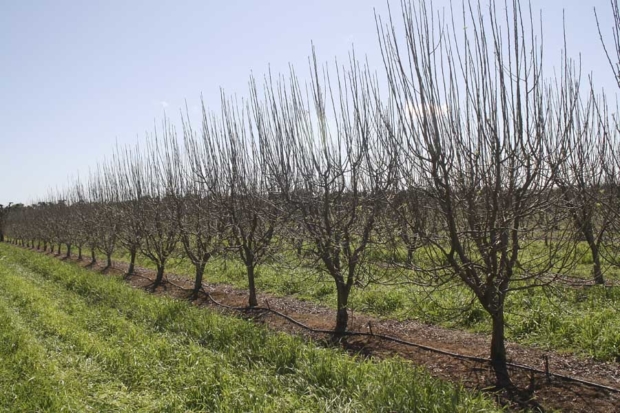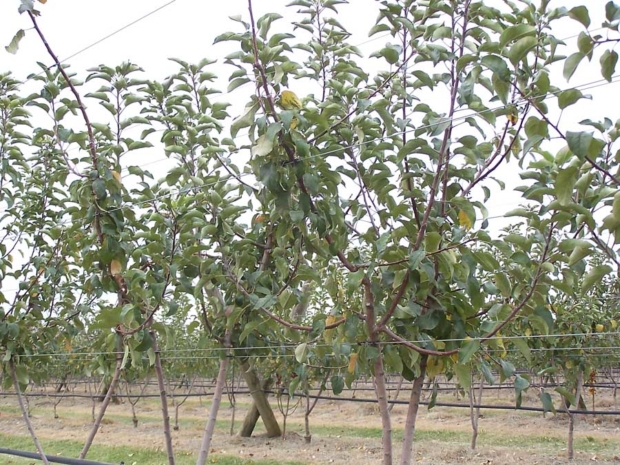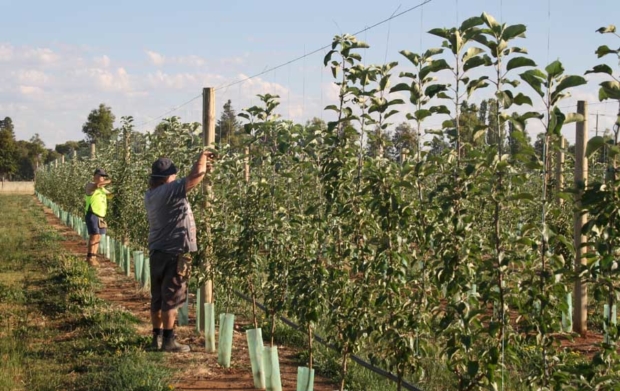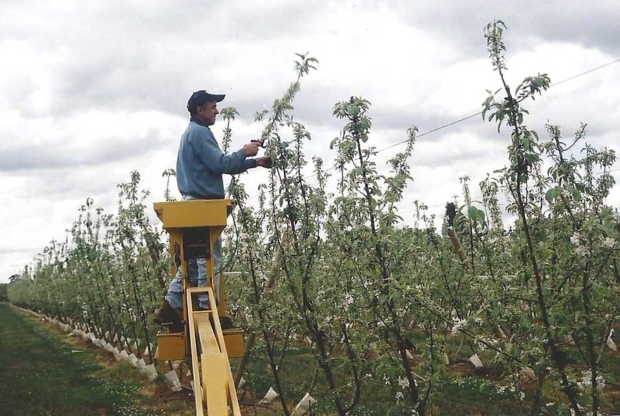
These 4-year-old Granny Smith trees on Malling-Merton 106 have been pruned every winter. Each time the leaders were headed to a weak lateral, except last winter (2016). The massive number of shoots that had to be removed does not make horticultural sense. Fortunately, the grower changed his method of pruning and can now better deal with the trees’ strong apical dominance, especially if the switch is made to summer pruning. Photo courtesy Bas van den Ende
With spring approaching in the Northern Hemisphere, a new season for orchardists starts with flowers, new leaves and shoots — and much anxiety.
Newly planted and young trees are encouraged to make as much growth as possible to fill their spaces quickly and start producing fruit.
Young trees can produce an abundance of new shoots. Some shoots are stronger than others, some have different angles than others, and some compete with the main leaders. Pruning some of the excess growth is necessary to keep the trees open and keep the right shape and balance.
The question is: What is the best time to do this pruning?
The time of year that you prune all trees makes a huge difference in how the trees respond to the pruning.
Summer
In summer, roots and top (the part that grows above the ground) grow in harmony; it’s called the allometric relationship between the roots and the top. This simple, universal equation applies to all plants. The roots need the top, and the top needs the roots. But ultimately, the roots control the top. That’s why we like to use size-controlling rootstocks (if available).
In summer, the leaves produce photosynthates, the “building blocks” for growth, in the form of carbohydrates, while the roots take up water and nutrients necessary for the “factory” to produce these building blocks. Leaves and roots also produce hormones, which are chemical compounds produced in minute amounts in one part of the tree and transported to another part where they trigger a response.
In summer, you can influence growth where you want it by removing superfluous shoot growth. The tree will redirect its growth when and where you want it to go. This is called summer pruning and can mean delay-heading shoots, tipping or stubbing new shoots, or removing new shoots entirely.
Summer pruning maximizes canopy growth and provides the type of wood that makes trees productive quickly and does not cause harmful internal shading.
Winter
Pruning young trees in winter, however, totally changes the tree’s responses from pruning in summer.
In winter, trees rest. The amount of roots and the amount of shoots have been determined. You might not like what you see if you pruned young trees in winter. Putting up with excessive shoot growth is not only expensive, the tree does not like you to remove it and will fight you until the roots have re-established the relationship with the top. The tree will often do this with more excessive shoot growth, especially in the top, where many heading cuts have been made.
It really does not make horticultural sense to prune young trees in winter, and then remove much of the shoots, only to repeat the practice next winter.
If you are not yet convinced, the pictures below may change your thinking and the time of pruning. •

These 3-year-old Modi/M9 trees on Tatura Trellis were left to grow at will. A few summer prunings would have ensured the development of two dominant leaders dressed with fruiting units. Instead, most of the new lateral shoots were removed, because they were too strong and competed with the leaders. As a consequence, the “snaking” of the leaders is not going to promote calm growth. Photo courtesy Bas van den Ende

These 2-year-old Modi/Malling 9 trees were meticulously trained and pruned in summer only. The two branchless leaders of each tree developed many fruiting units. There has been no need to touch these trees in winter. Photo courtesy Bas van den Ende

When trees reach their maximum permissible height, do not head them in winter, but wait and make the heading cuts in late spring. This is called delay-heading and the trees cannot respond as they do when you head in winter. It is all a matter of timing. Photo courtesy Bas van den Ende
— by Bas van den Ende, a tree fruit consultant in Australia’s Goulburn Valley.






[…] Magazine has a ‘good’ 🙂 article archived in the March 2017 edition called – Don’t Invest in Unwanted Growth. Young Trees Can Benefit from Pruning in the Summer.” Yay! Now I don’t have to feel guilt ridden by not pruning in the cold spring […]